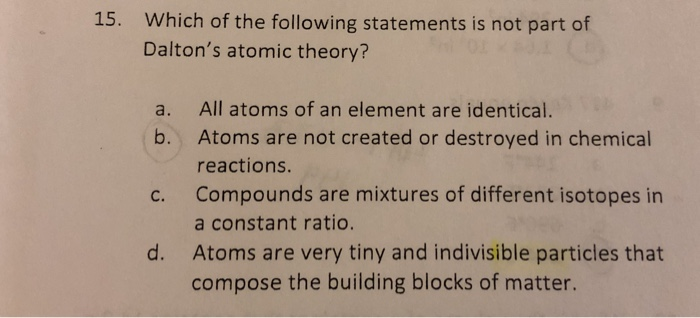C Atoms of different elements combine in fixed ratios to form compounds. 5 Chemical reactions cause atoms to be rearranged.
Dalton based his theory on the law of conservation of mass and the law of constant composition.

. Which of the following is not correct according to Daltons atomic theory. According to his theory. Which of the following statements is.
CAll matter consists of atoms. Which statements belong to daltons atomic theory. John Dalton was the first scientist to propose the theory of atom.
Correct option is C Answer C. The crucial ideas of Daltons theory were. Put that idea with the common phrase you are what you eat.
Which of the following parts of John Daltons atomic theory if correct would have made it impossible for Marie Curies discovery that new elements can be produced when elements are bombarded with neutrons. Select all that apply. According to Johns Daltons modern theory of an atom.
Main postulates of Daltons atomic theory are. 3 Atoms can neither be created nor destroyed. Daltons atomic theory was the first complete attempt to describe all matter in terms of atoms and their properties.
Select all that apply 1 Atoms have a massive positively charged center. DCompounds result from the combination of a specific ratio of atoms of different elements. All matter is composed of atoms.
Correct incorrect The following is the final score of. Option b is correct In Daltons atomic theory he didnt mention about the nucleus and its constituents of an atom. Different elements have different types of atom.
Which of the following options correctly describe Daltons atomic theory. All matter is made up of small particles called atoms. Option C is not included in the John Daltons modern theory of an atom.
One key point in Daltons atomic theory was Chemical reactions involve reorganization of the atoms- changes the way they are bound together. Daltons atomic theory was the first complete attempt to describe all matter in terms of atoms and their properties. Measurements of the angles between the screen metal foil and the source determined the scatter pattern of the particles.
B The properties of all the atoms of a given element are the same including mass. Choose correct punctuation Wednesday is the picnic. Select all that apply.
The first part of his theory states that all. 3 Atoms can neither be created nor destroyed. Hey have the same outer electron configuration.
4 All atoms of an element are identical. AAtoms of same elements can have different masses. CThe atoms of different elements combine in same rates of number to.
Atoms are composed of electrons protons and neutrons. Daltons atomic theory was the first complete attempt to describe all matter in terms of atoms and their properties. Which of the following options correctly describe Rutherfords experiment to discover the nature of the atom.
Isotopes of the same element have different masses. 3 Atoms cannot be broken down into smaller pieces. Daltons atomic theory stated that matter consists of tiny indivisible particles called atoms which combine in definite whole-number ratios to form compounds Thomson discovered that cathode rays emanate from the negative electrode.
Friday is the senior dance. The answer for the following question is option C. 1 Elements consist of indivisible small particles atoms.
Atoms are composed of electrons protons and neutrons. Daltons atomic theory. - Atoms are indivisible.
Select all that apply. - Different atoms combine to form molecules. Nuclear fission is a.
View the full answer. Dalton based his theory on the law of conservation. 2 Atoms cannot be created or destroyed.
BAtoms combine randomly to form a given compound. 2 All atoms of the same element are identical. BAtoms of sarne elements will be same in all respect.
Describe the structure of the atom by explaining how Daltons atomic theory has changed due to scientific discoveries. The first part of his theory states that all matter is made of atoms which are indivisible. It states atoms of different elements combine to form new compound but not new elements.
Correct option is B Daltons atomic theory was given by John Dalton. DAtom is indivisible and indestructible. A chemical reaction is a rearrangement of atoms.
According to the Postulates of Daltons atomic theory atoms are further indivisible and all matter is composed of smallest particles called atom. It involves the following postulates. - Atoms of the same element have identical mass size and properties.
This among other experimental evidence caused him to postulate that they consist of particles of the same charge. So the statement atoms can be divided into electrons protons and neutrons is not the postulate of Daltons atomic theory. A theory of chemical combination first stated by John Dalton in 1803.
Daltons atomic theory stated that matter consists of tiny indestructible particles called _____ which combine in definite ratios to form _____. AAtoms of one element can be converted into atoms of another element. Thus based on the given options the statement that best describes an.
Which of the following is not part of Daltons atomic theory. Atoms of the same element are identical. Which of the following options correctly describe Daltons atomic theory.
Compounds or chemical compounds. - All matter is composed of atoms. A Matter is made up of invisible particles known as atoms.
Option b is correct In Daltons atomic theory he didnt mention about the nucleus and its constituents of an atom.

Solved Which Of The Following Statements Is Not Part Of Chegg Com

What Does Dalton S Atom Look Like Quora

Which Of The Following Is Not The Basic Postulates Of Dalton S Atomic Theory
0 Comments